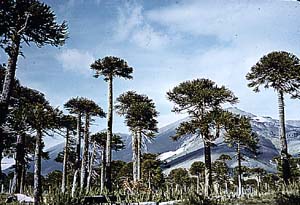



Araucariaceae: morphology






Both genera have symmetrical growth. Araucaria branches form regular whorls at each node. The bottom branches are deciduous leaving a bare trunk with a umbrella-like crown at the apex. Agathis also has early deciduous branches that leave smooth scars and a smooth cylindrical trunk. The trees generally have large dividing branches near the top that form an immense spreading crown. Much research must still be done on Wollemia, but it is generally a larger tree with similar architecture to Araucaria and Agathis. However, it does not have a smooth trunk, but instead a bumpy or warty bark.
Leaves
Araucaria has broad sessile leaves that completely cover the shoot. They can be lanceolate, flat, leathery, sharp-pointed, or awl shaped; with several parallel veins or smaller with a single vein. The leaves are spirally arranged and they are clasping the stem while overlapping. The leaves can vary in size and shape on different parts of the same tree. Agathis leaves are also broad, but they are less crowded and are generally bigger than Araucaria. The leaves can also be lanceolate to ovate in shape. They have a distinct petiole and tapering apices, and are oppositely arranged on branches. Agathis leaves also have a obvious palisade level. The leaves of Wollemia are very distinct; with parallel longitudinal veins, trimorphic leaves, and no conspicuous midrib.
Reproductive Structures
Araucaria can be monoecious or dioecious, in some species the male and female cones are found on different branches of the same tree. The pollen cones are dense and cylindrical occurring solitarily or clustered at the points of branches. The female cones can be round or ovoid. They are woody with closely over-lapping scales that fall when the seeds are mature. The cones ripen over a period of 2-3 years. There is one seed on each scale; and they adhere to the scale. The seeds are winged on each edge allowing easier dispersal. Agathis is monoecious. The male and female cones are usually found on the same tree. The seed of Agathis is free from the scale, usually having only one well-developed wing. The pollen cone is stiff, dense, cylindrical, and solitary; usually being found in the leaf axils. The female cones are also round and ovoid, but they are compact and symmetrical. The scale is usually fan-shaped with a thickened margin and usually overlap the scale above it. The cone usually falls after the seeds are away.
Agathis is monoecious. The male and female cones are usually found on the same tree. The seed of Agathis is free from the scale, usually having only one well-developed wing. The pollen cone is stiff, dense, cylindrical, and solitary; usually being found in the leaf axils. The female cones are also round and ovoid, but they are compact and symmetrical. The scale is usually fan-shaped with a thickened margin and usually overlap the scale above it. The cone usually falls after the seeds are away.
Significant differences of Wollemia cones are still being catalogued, but some details are known. For instance, both female and male cones are fused completely to the spiny bracts, with are helically arranged. The seed have a single circumferential wing which is free from the bract-scale complex.
Wood
The wood of Araucaria is resinous, yellowish white, and straight-grained. It is easily worked with and is useful for many purposes, especially for paper pulp. The bark of Araucaria is resinous and very thick on old trees. It is ridged with the bases of old leaves; or, in some species, it is rough and peeling off in papery scales. Agathis wood is of good quality and is also easily worked. It is very useful for various building purposes. The bark of Agathis is thick, scaly, and resinous. It emits a thick milky liquid when punctured, this liquid eventually solidifies and forms an incrustation on the bark. Wollemia has a thin, spongy, nodular bark which sheds its outer surface in thin papery scales.


